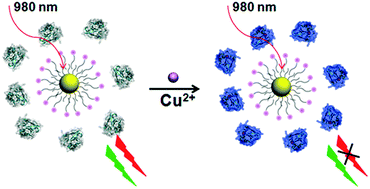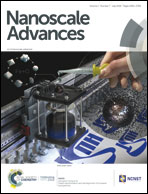Cupredoxin engineered upconversion nanoparticles for ratiometric luminescence sensing of Cu2+†
Abstract
The NIR excitation and large anti-Stokes shift of upconversion nanoparticles (UCNPs) have made them an ideal choice as biological nanoprobes. A key challenge in the field is to confer biorecognition units to UCNPs so that they can be used to probe specific targets in biological systems. While various agents have been combined with UCNPs to meet such a challenge, most studies are limited to small molecules, while biomolecules such as metalloproteins that possess much higher affinity and selectivity for metal ions have not been explored. Herein we demonstrate that fusion of zwitterion-coated UCNPs with azurin, a member of a family of redox-active copper proteins called cupredoxins that play important roles in diverse biological functions, can serve as an ideal platform for the label-free upconversion luminescence sensing of Cu2+ with a ratiometric response. The selective binding of apo-azurin with Cu2+ induces a significant absorbance at about 625 nm, and hence decreases the red emission of the UCNPs. In contrast, the green emission of the UCNPs remains constant and acts as an internal standard reference for the ratiometric sensing of Cu2+. This approach opens a new window for the development of assays for biosensing based on a combination of specific metalloproteins with UCNPs.

- This article is part of the themed collections: Research selection from the NCNST and Celebrating our 2020 Prize and Award winners


 Please wait while we load your content...
Please wait while we load your content...